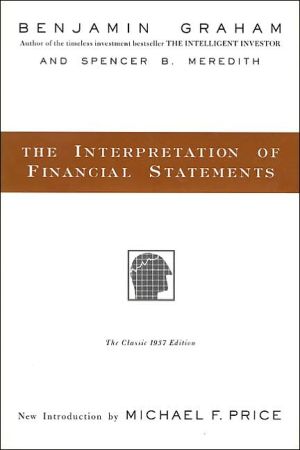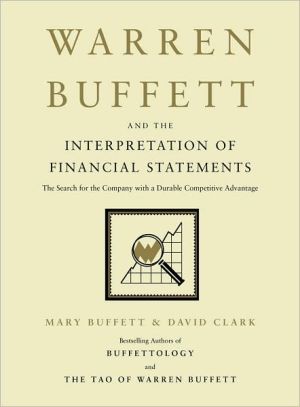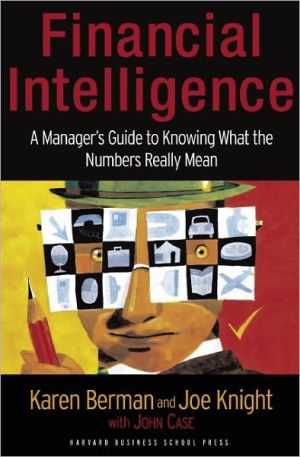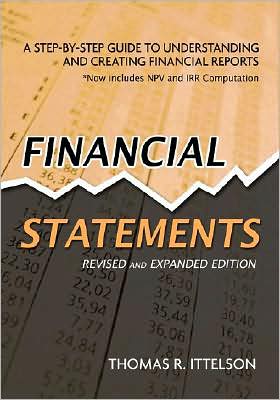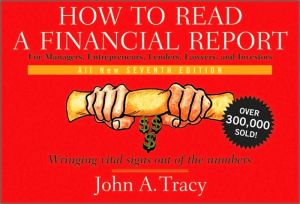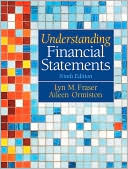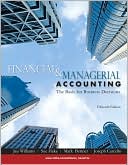The Interpretation of Financial Statements: The Classic 1937 Edition
"All investors, from beginners to old hands, should gain from the use of this guide, as I have."\ From the Introduction by Michael F. Price, president, Franklin Mutual Advisors, Inc.\ Benjamin Graham has been called the most important investment thinker of the twentieth century. As a master investor, pioneering stock analyst, and mentor to investment superstars, he has no peer.\ The volume you hold in your hands is Graham's timeless guide to interpreting and understanding financial...
Search in google:
"All investors, from beginners to old hands, should gain from the use of this guide, as I have." From the Introduction by Michael F. Price, president, Franklin Mutual Advisors, Inc. Benjamin Graham has been called the most important investment thinker of the twentieth century. As a master investor, pioneering stock analyst, and mentor to investment superstars, he has no peer. The volume you hold in your hands is Graham's timeless guide to interpreting and understanding financial statements. It has long been out of print, but now joins Graham's other masterpieces, The Intelligent Investor and Security Analysis, as the three priceless keys to understanding Graham and value investing. The advice he offers in this book is as useful and prescient today as it was sixty years ago. As he writes in the preface, "if you have precise information as to a company's present financial position and its past earnings record, you are better equipped to gauge its future possibilities. And this is the essential function and value of security analysis." Written just three years after his landmark Security Analysis, The Interpretation of Financial Statements gets to the heart of the master's ideas on value investing in astonishingly few pages. Readers will learn to analyze a company's balance sheets and income statements and arrive at a true understanding of its financial position and earnings record. Graham provides simple tests any reader can apply to determine the financial health and well-being of any company. This volume is an exact text replica of the first edition of The Interpretation of Financial Statements, published by Harper & Brothers in 1937. Graham's original language has been restored, and readers can be assured that every idea and technique presented here appears exactly as Graham intended. Highly practical and accessible, it is an essential guide for all business people—and makes the perfect companion volume to Graham's investment masterpiece The Intelligent Investor. Michael F. Price This reissue of the classic 1937 edition ... is right on time.... [The] basic study of financial statements by the average investor is more important than ever.
Introduction\ In the spring of 1975, shortly after I began my career at Mutual Shares Fund, Max Heine asked me to look at a small brewery-the F&M Schaefer Brewing Company. I'll never forget looking at the balance sheet and seeing a +/- $40 million net worth and $40 minion in "intangibles". I said to Max, "It looks cheap. It's trading for well below its net worth.... A classic value stock!" Max said, "Look closer."\ I looked in the notes and at the financial statements, but they didn't reveal where the intangibles figure came from. I called Schaefer's treasurer and said, "I'm looking at your balance sheet. Tell me, what does the $40 million of intangibles relate to?" He replied, "Don't you know our jingle, 'Schaefer is the one beer to have when you're having more than one.'?"\ That was my first analysis of an intangible asset which, of course, was way overstated, increased book value, and showed higher earnings than were warranted in 1975. All this to keep Schaefer's stock price higher than it otherwise should have been. We didn't buy it,\ How many of today's jingles are carried on balance sheets? Billions? Or have things changed? Do companies like Coca-Cola, Philip Morris, and Gillette have huge "intangible" assets that they now leverage worldwide and don't even carry on their balance sheets?\ This reissue of the classic 1937 edition of Ben Graham and Spencer Meredith's The Interpretation of Financial Statements is right on time. Since our accounting conventions have been and continur- to be both inadequate and constantly changing to keep up with the evolution of businesses, the basic study of financial statements by the average investor(businesspeople and school teachers, for example), is more important than ever.\ In 1998 , we are twenty years into a huge merger wave where most well-known large companies have acquired one or more other businesses. These companies' financial statements have become, as a result, harder and harder to true up. Currently the Financial Accounting Standards Board is studying whether to eliminate the pooling of interest method of accounting for acquisitions; this change would increase the amount of goodwill put on balance sheets. Pooling allows a company to combine its accounts with those of a merged or acquired company without listing goodwill. Pooling also restricts stock buybacks, while the purchase method of accounting (the other method of accounting in a merger or acquisition) allows stock buybacks and requires that any goodwill be amortized over a period not to exceed forty years. The request to record goodwill could result in lower acquisition premiums and corporate valuation levels.\ Wells Fargo and First Interstate, two banks that merged in 1996, used purchase accounting while the recent Chase Manhattan Bank and Chemical Bank merger used the pooling method. In examining the results going forward from those mergers and others like them that the accounting methods need to be interpreted consistently. For example, Wells Fargo is using cash flow to buy back stock even after almost $300 million per year in goodwill amortization and now reports "cash earnings", as well as regular earnings, after amortization earnings per share. We at Mutual Shares look harder at "cash earnings" than earnings after amortization of goodwill in those industries where we see many deals and much goodwill created. The accurate interpretation on the part of investors of these accounting issues and corporate behavior changes is key in today's fastpaced market. Ben Graham's principle of always returning to the financial statements will keep an investor from making huge mistakes, and without huge mistakes the power of compounding can take over.\ Whether you are a disciple of Ben Graham, a value investor, or a growth or momentum investor, you can agree that a stock's price must relate to its financials. From time to time investors ignore basic numbers like book value, cash flow, interest, and various ratios that fundamentally value common stock. It is especially common during periods of exuberance or fear that investors depart from the fundamental methods of successful investing. A sound understanding of how to read the basic financials should keep investors focused and thereby avoid costly mistakes, and also helps to uncover the hidden values of Wall Street.\ Contemporary businesses are vastly more global than ever. Many of their globally distributed products are the result of decades of research and millions of dollars in promotions, yet they don't mention any intangibles on the balance sheet, because they're reflected in the market price. But how much will the market pay for a brand name, and why? Does the amount relate to the cash flows these well-known products produce? Global comparties have gotten pretty good at leveraging their brands. Airlines are using computers for optimum load factors. Management information systems are helping to produce greater returns from assets than ever before. As companies globalize both directly, and through joint ventures, the true values of the name brands will take shape. Investors using financial statements can then determine how much the market is assigning to their "product" and "brand name" intangibles.\ The Interpretation of Financial Statements was first published in 1937, shortly after the Ben Graham bible, Security Analysis, and during an era when investors left the stock market in droves. Today, when the contrary is the case, investors should confirm their understanding of the financial statements of the companies whose stock they own. This manual takes you through both the balance sheet (what a company owns and owes) and the income statement (what it earns). Helpful discussions of other statements, ratios, and a glossary of frequently used terms are also included.\ Earnings reports, annual reports, and news releases concerning charges, reserves, and restatement of earnings, to name just a few subjects, will all become clearer with this book in hand. All investors, from beginners to old...\ The Interpretation of Financial Statements. Copyright © by Benjamin Graham. Reprinted by permission of HarperCollins Publishers, Inc. All rights reserved. Available now wherever books are sold.
PART I. BALANCE SHEETS AND INCOME ACCOUNTSPREFACE viiI. BALANCE SHEETS IN GENERAL 3 II. DEBITS AND CREDITS 5 III. TOTAL ASSETS AND TOTAL LIABILITIES 9 IV. CAPITAL AND SURPLUS 11 V. PROPERTY ACCOUNT 14 VI. DEPRECIATION AND DEPLETION 16 VII. NON-CURRENT INVESTMENTS 19 VIII. INTANGIBLE ASSETS 21 IX. PREPAID EXPENSES 24 X. DEFERRED CHARGES 26 XI. CURRENT ASSETS 28 XII. CURRENT LIABILITIES 30 XIII. WORKING CAPITAL 31 XIV. CURRENT RATIO 34 XV. INVENTORIES 36 XVI. RECEIVABLES 39 XVII. CASH 41 XVIII. NOTES PAYABLE 43 XIX. RESERVES 45 XX. BOOK VALUE OR EQUITY 48 XXI. CALCULATING BOOK VALUE 50 XXII. BOOK VALUE OF BONDS AND STOCKS 52 XXIII. OTHER ITEMS IN BOOK VALUE 54 XXIV. LIQUIDATING VALUE AND NET CURRENT Asset Value 55 XXV. EARNING POWER 57 XXVI. A TYPICAL PUBLIC UTILITY INCOME ACCOUNT 58 XXVII. A TYPICAL INDUSTRIAL INCOME ACCOUNT 61 XXVIII. A TYPICAL RAILROAD INCOME ACCOUNT 62 XXIX. CALCULATING EARNINGS 64 XXX. THE MAINTENANCE AND DEPRECIATION FACTOR 67 XXXI. THE SAFETY OF INTEREST AND PREFERRED DiVIDENDS 70 XXXII. TRENDS 72 XXXIII. COMMON STOCK PRICES AND VALUES 74 XXXIV. CONCLUSION 77 PART II. ANALYZING A BALANCE SHEET AND INCOME ACCOUNT BY THE RATIO METHOD 81 PART III. DEFINITIONS OF FINANCIAL TERMS AND PHRASES 91
\ Michael F. PriceThis reissue of the classic 1937 edition ... is right on time.... [The] basic study of financial statements by the average investor is more important than ever.\ \ \ \ \ Smart MoneyGraham's ideas ... formed the framework of thinking about the stock market that has inspired the investment community for nearly a century.\ \ \ John TrainGraham ranks as this century's (and perhaps history's most important thinker on applied portfolio investment.\ \ \ \ \ BooknewsReprint with a new introduction by Michael F. Price. Annotation c. by Book News, Inc., Portland, Or.\ \
